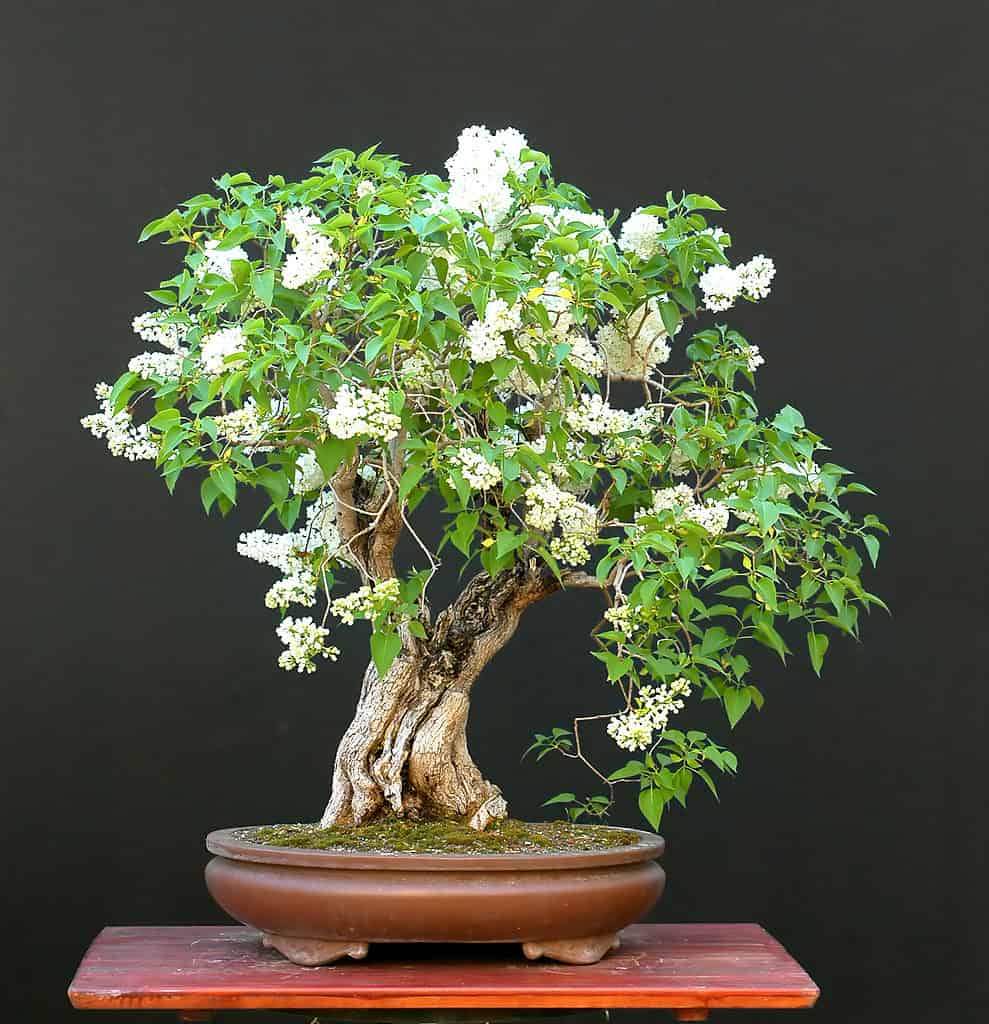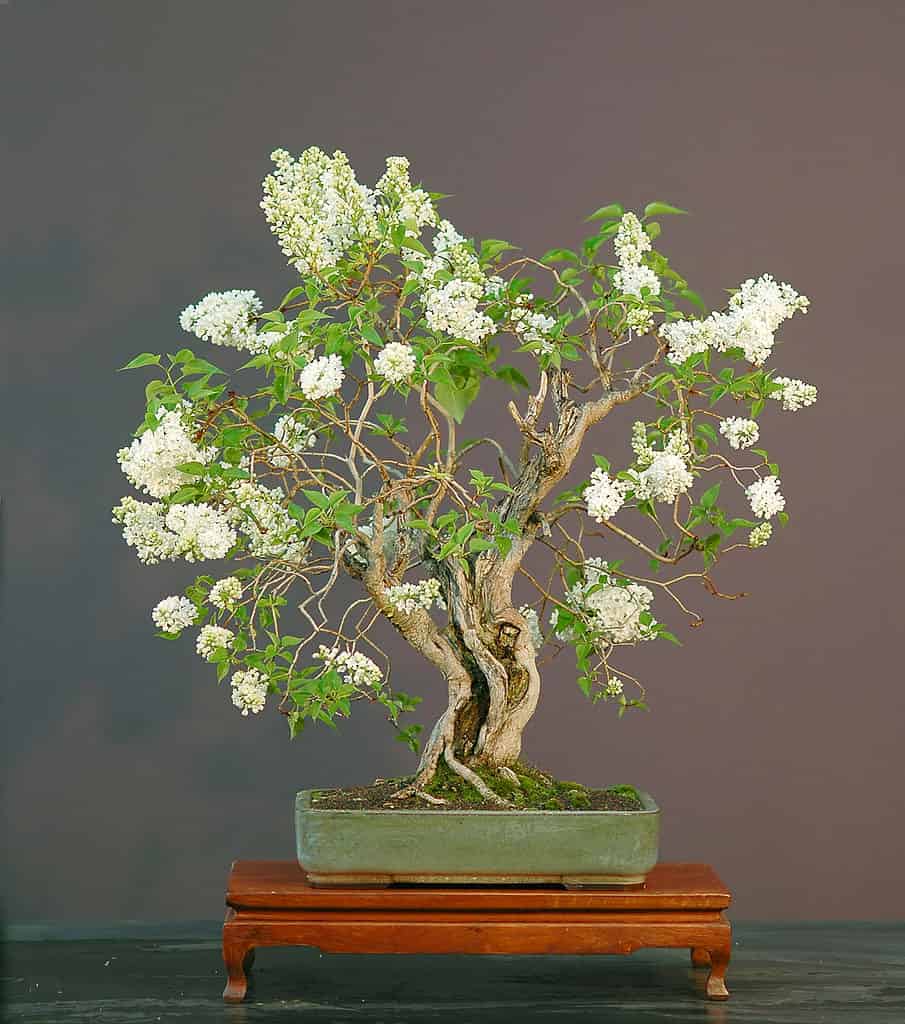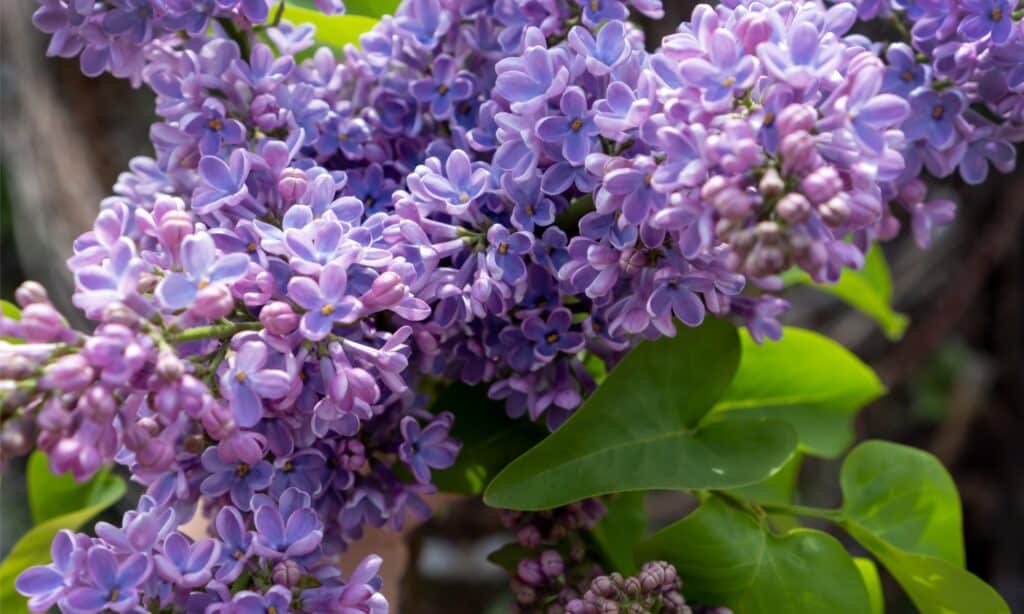Did you know that you can grow most lilac species as a lilac Bonsai tree? Members of the Syringa plant genus, lilac shrubs and trees are incredibly popular in the average backyard garden. With fragrant flowers and many dwarf cultivars, lilacs are well-suited to flowering Bonsai tree cultivation, both for beginners and experienced Bonsai tree artists alike.
When it comes to caring for a lilac Bonsai tree, there are a number of things to consider. From the correct placement of your Bonsai tree to pruning and shaping, lilacs are fairly forgiving. However, certain rules should be followed to promote ample flower growth and production. Here’s everything you need to know about lilac Bonsai tree care.

While a common garden lilac will work in Bonsai tree cultivation, dwarf species or cultivars are better suited to container growth.
©Walter Pall/Shutterstock.com
| Lilac Bonsai Tree | |
|---|---|
| Botanical Name | Syringa |
| Common Cultivars | Dwarf Korean lilacs are most common; ‘Superba’, ‘Palibin’, ‘Bloomerang’, ‘New Age’ |
| Sunlight | Full, direct sunshine for best flower growth |
| Soil | Well-draining, with plenty of substances mixed in (clay, peat, coconut fibers, akadama clay) |
| Water | Plenty of water, particularly during the growing season; try to keep roots from sitting in water |
| For Beginners? | Yes; forgiving of most pruning and very hardy in cold temperatures |
| Indoors or Outdoors? | Outdoors, down to 10 degrees Fahrenheit |
| Pairs Well With… | Larger pots with enough room for moss and other accents; styling should be specific for promoting flower growth! |
Common Types of Lilac Bonsai Trees

Given their positive responses to pruning and relative ease of care when kept outdoors, lilac Bonsai trees are recommended for all levels of Bonsai tree artists.
©Walter Pall/Shutterstock.com
There are roughly 12 different species of lilac shrubs and trees in the Syringa genus found around the world. There are even more cultivars and subspecies of lilac trees, including hybrids. While a common garden lilac will work in Bonsai tree cultivation, dwarf species or cultivars are better suited to container growth. The dwarf Korean lilac is particularly popular given its small growth habit. Here are some cultivars to consider for your lilac Bonsai tree, all small options.
‘Superba’
Also known as a littleleaf lilac, the ‘Superba’ cultivar grows petite blossoms and foliage with the potential for reblooming twice in a given year. This particular lilac tree produces small pink flowers and is particularly frost-hardy down to Zone 4. While not the smallest of lilac cultivars, this option works well for Bonsai tree cultivation.
‘Palibin’
A dwarf Korean lilac cultivar, ‘Palibin’ produces heaps of fragrant flowers in the spring. It is ideal for compact spaces and therefore Bonsai tree cultivation. The slow growth habit of this shrub is also a plus. The ‘Palibin’ cultivar is hardy down to Zone 3 and produces rust-colored foliage in the fall.
‘Bloomerang’
With multiple flower colors and the potential for a spring, summer, and even fall bloom, the ‘Bloomerang’ lilac cultivar is worth looking into. Some plants are dwarf varieties and these should be considered before a full-size specimen. However, with plenty of light and a colder winter season, you can expect your ‘Bloomerang’ to produce plenty of flowers!
‘New Age’
With a smaller growth habit and delicate purple or white blooms, ‘New Age’ lilac cultivars are ideal for Bonsai tree cultivation. Still requiring full sun like other lilac tree types, ‘New Age’ lilacs enjoy temperatures down to Zone 3. Plus, you will only get one round of flowers from this cultivar, making it easy to anticipate pruning times.
Caring for Your Lilac Bonsai Tree

If you want your lilac Bonsai tree to produce multiple flowers throughout spring, giving it plenty of sunshine is your best bet.
©Renata Ty/Shutterstock.com
Given their positive responses to pruning and relative ease of care when kept outdoors, lilac Bonsai trees are recommended for all levels of Bonsai tree artists. Beginners may enjoy this option if they are worried about pruning too much or too heavily. While lilac trees do indeed need specific pruning in order to produce their signature flowers, you likely won’t prune your lilac tree too much!
However, there are many important things to consider before beginning a lilac Bonsai tree, including just how long it takes for these beautiful specimens to bloom and grow. Here are some basics when it comes to caring for a lilac plant, especially if you want to cultivate one in a container.
Sunlight
If you want your lilac Bonsai tree to produce multiple flowers throughout spring, giving it plenty of sunshine is your best bet. Full sunshine is ideal for just about every lilac tree cultivar, especially when grown in miniature. You may be tempted to give your lilac Bonsai tree some shade during the hottest parts of the year, but this is only necessary for certain climates that aren’t necessarily suited to lilac shrub growth.
Soil Type
Most lilac trees do well in a variety of soil types and conditions, but all plants grown in miniature require well-draining soil and soil components. Lilac Bonsai trees prefer Bonsai tree soil mixed with other natural materials such as peat and coconut fibers or other organic materials. Mixing potting soil with clay or pumice stones also works well for lilac plants.
Water
Plenty of water is the other component of growing a lilac Bonsai tree with plenty of flowers. However, all Bonsai tree specimens need a strict and specific watering routine so that you don’t over or under-water them. Most lilac tree specimens can handle more water rather than less, but losing foliage is a sign that your lilac tree is getting too much moisture. Root rot can plague any Bonsai tree type, but plenty of water is necessary during the lilac growing season.
Placement
Your lilac Bonsai tree will need to be grown outdoors in order to thrive. Indoor living conditions do not suit lilac plants and your specimen will suffer indoors. However, make sure to keep your Bonsai tree in a location out of high winds and shade. Full sunlight is necessary during the spring and summertime to produce beautiful flowers.
However, you may need to physically plant your lilac shrub during its winter dormancy period. The cold temperatures of fall and winter are necessary to ensure flower production, but Bonsai trees have very few ways in which they can protect their roots. If you don’t want to repot your Bonsai tree every spring season, consider keeping your lilac specimen in a garage or cold location during the wintertime.
Pruning Your Lilac Bonsai Tree

Most lilac tree specimens can handle more water rather than less, but losing foliage is a sign that your lilac tree is getting too much moisture.
©Olena Antonenko/Shutterstock.com
Lilac Bonsai trees make ideal specimens for those of you worried about pruning. While some Bonsai tree types need to be pruned with care, it is necessary to prune your lilac Bonsai tree after it has bloomed. If you want even more flowers to grow on your miniature lilac tree, pruning and plenty of sunshine are the way to go!
Regular pruning and maintenance will also keep your lilac Bonsai tree compact. By pruning any unnecessary branches, you are redirecting your lilac plant’s energy back into its trunk, typically resulting in a thicker, fuller appearance. However, pruning all new growth will not encourage flower production, so keep this in mind as you carefully trim your springtime lilac specimen.
Finally, many Bonsai tree artists struggle with pruning lilac trees because of the way that their flowers grow. Most of the time, lilacs produce blooms at the end of their branches, resulting in a Bonsai tree specimen that is leggy and difficult to style. However, lilac plants produce beautiful flowers and beautiful bark, so styling your Bonsai tree should be a joy, no matter the season!
Recommended Lilac Bonsai Tree Styles
As previously mentioned, the lilac Bonsai tree struggles with certain styles that don’t promote flower production. However, having fewer options in terms of its shape may be discouraging to some of you. Choosing a Bonsai tree style that incorporates flower design is always a good idea, but keep in mind that most lilac tree species produce flowers that often overwhelm a tree grown in miniature.
Many Bonsai tree artists choose an informal upright design or a multi-trunked design that supports flower production. While you’ll still have attractive bark for the rest of the year, there’s nothing like a lilac Bonsai tree in bloom! You may choose to grow your lilac specimen in a larger pot than average so that you can have as many flowers as possible.
Propagating Your Lilac Bonsai Tree

By pruning any unnecessary branches, you are redirecting your lilac plant’s energy back into its trunk, typically resulting in a thicker, fuller appearance.
©Walter Pall/Shutterstock.com
The best way to propagate a lilac Bonsai tree is by using an existing specimen. Growing lilac trees from seed take far too long for Bonsai tree production, but you need to propagate a lilac tree cutting with care. For best results when grown in a miniature format, you should choose a lilac shrub or tree that is older than average, with plenty of old wood to make a clean cut from.
You might also get lucky and find an old lilac tree or shrub that is being dug up. Taking a root or a stump is sometimes one of the best options for producing a lilac Bonsai tree that is strong, full of flowers, and easy to prune. No matter what, propagate your lilac Bonsai tree using a cutting from an older portion of an existing specimen, not from new growth!
Common Problems with Lilac Bonsai Trees

Growing lilac trees from seed take far too long for Bonsai tree production, but you need to propagate a lilac tree cutting with care.
©iStock.com/Diana Ibrasheva
Besides common pests and diseases that plague the average outdoor shrub, lilac Bonsai trees typically produce larger flowers and leaves than the average Bonsai tree. Many beginning Bonsai tree artists choose to propagate a lilac tree and assume that the leaves or flowers will grow in miniature. However, once this is clearly not the case, many Bonsai tree styles or designs are compromised by the larger growth habits of the average lilac plant.
Besides stylistic disappointments, lilac Bonsai trees may experience a number of fungal or bacterial infections. For example, spotting leaves and powdery mildew are common enough problems for an outdoor-grown Bonsai tree, but you can treat these problems with a number of products. Just like fungal infections, some pests that may plague your Bonsai tree include scale and different types of borers.
If you happen to have an older lilac tree or shrub on your property, it’s likely fairly inexpensive to begin cultivating a lilac Bonsai tree. Keep in mind that the larger growth habits of most lilac trees need extensive pruning in order to be grown in miniature. However, this is great practice for the beginning Bonsai tree artist and the experienced one alike!
The photo featured at the top of this post is © Walter Pall/Shutterstock.com
Thank you for reading! Have some feedback for us? Contact the AZ Animals editorial team.






